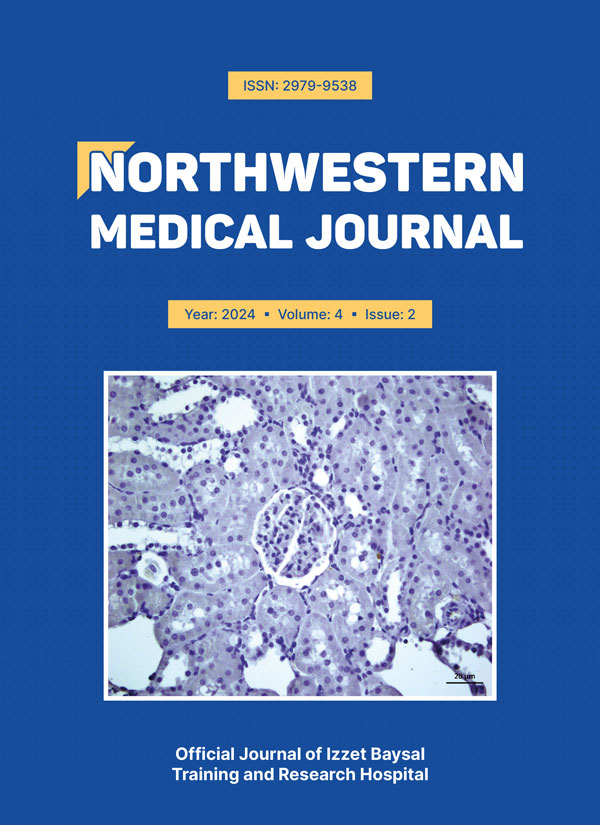Abstract
Aim: Acute neurological complaints are one of the reasons why children present to pediatric emergency departments. Neuro-imaging techniques gain more importance in children since physical examination and anamnesis do not provide sufficient information due to insufficient cooperation. We aimed to determine the distribution of patients who applied to the pediatric emergency department with non-traumatic acute neurological complaints and underwent neu-roimaging, and the clinical benefit of neuroimaging in these patients.
Methods: The information and records of the patients who applied to the Konya City Hospital Pediatric Emergency Clinic between January 1 and October 1, 2022, due to acute neurological complaints and underwent neuroimaging were retrieved and analyzed retrospectively. Acute neurological complaints of the patients were classified according to the International Classifi-cation of Diseases-10 diagnostic coding.
Results: This study included 180 (50.5% male) patients. The median age of the patients was 120 (interquartile range: 45-180) months. Afebrile convulsion was the most common reason for admission in 69 patients (38.3%). Cranial computed tomography (CCT) was performed in all 180 patients. Of the patients, 68 (37.8%) only underwent CCT scan, while 90 (50%) had diffusion magnetic resonance imaging (MRI), 20 (11.1%) had brain+diffusion MRI, and 2 (1.1%) had brain+diffusion+spinal MRI. Neuroimaging abnormalities were statistically higher in patients with abnormal physical examination findings than in patients with normal physical examination findings (p<0.001).
Conclusion: Neuroimaging results are mostly normal even in the presence of symptoms such as seizures, headaches, and impaired consciousness. Therefore, neuroimaging should be planned by considering not only the acute neurological complaint on admission but also the physical examination findings.
Keywords: acute neurological complaints, neuroimaging, pediatric emergency
Copyright and license
Copyright © 2024 The Author(s). This is an open-access article published by Bolu İzzet Baysal Training and Research Hospital under the terms of the Creative Commons Attribution License (CC BY) which permits unrestricted use, distribution, and reproduction in any medium or format, provided the original work is properly cited.
How to cite
References
- Pope D, Fernandes CM, Bouthillette F, Etherington J. Frequent users of the emergency department: a program to improve care and reduce visits. CMAJ. 2000; 162(7): 1017-20.
- Saigal G, Ezuddin NS, Vega G. Neurologic Emergencies in Pediatric Patients Including Accidental and Nonaccidental Trauma. Neuroimaging Clin N Am. 2018; 28(3): 453-70. https://doi.org/10.1016/j.nic.2018.03.007
- Yazıcı Z. Çocuk Nörolojisinde Görüntüleme. Güncel Pediatri Dergisi. 2008; 6(1): 165-70.
- Smith-Bindman R, Miglioretti DL, Larson EB. Rising use of diagnostic medical imaging in a large integrated health system. Health Aff (Millwood). 2008; 27(6): 1491-502. https://doi.org/10.1377/hlthaff.27.6.1491
- Prabhu SP, Young-Poussaint T. Pediatric central nervous system emergencies. Neuroimaging Clin N Am. 2010; 20(4): 663-83. https://doi.org/10.1016/j.nic.2010.07.008
- Chang PT, Yang E, Swenson DW, Lee EY. Pediatric Emergency Magnetic Resonance Imaging: Current Indications, Techniques, and Clinical Applications. Magn Reson Imaging Clin N Am. 2016; 24(2): 449-80. https://doi.org/10.1016/j.mric.2015.11.009
- Fisher RS, van Emde Boas W, Blume W, et al. Epileptic seizures and epilepsy: definitions proposed by the International League Against Epilepsy (ILAE) and the International Bureau for Epilepsy (IBE). Epilepsia. 2005; 46(4): 470-2. https://doi.org/10.1111/j.0013-9580.2005.66104.x
- Hirtz D, Ashwal S, Berg A, et al. Practice parameter: evaluating a first nonfebrile seizure in children: report of the quality standards subcommittee of the American Academy of Neurology, The Child Neurology Society, and The American Epilepsy Society. Neurology. 2000; 55(5): 616-23. https://doi.org/10.1212/wnl.55.5.616
- Veerapandiyan A, Aravindhan A, Takahashi JH, Segal D, Pecor K, Ming X. Use of Head Computed Tomography (CT) in the Pediatric Emergency Department in Evaluation of Children With New-Onset Afebrile Seizure. J Child Neurol. 2018; 33(11): 708-12. https://doi.org/10.1177/0883073818786086
- Ozge A, Termine C, Antonaci F, Natriashvili S, Guidetti V, Wöber-Bingöl C. Overview of diagnosis and management of paediatric headache. Part I: diagnosis. J Headache Pain. 2011; 12(1): 13-23. https://doi.org/10.1007/s10194-011-0297-5
- Zwart JA, Dyb G, Holmen TL, Stovner LJ, Sand T. The prevalence of migraine and tension-type headaches among adolescents in Norway. The Nord-Trondelag Health Study (Head-HUNT-Youth), a large population-based epidemiological study. Cephalalgia. 2004; 24(5): 373-9. https://doi.org/10.1111/j.1468-2982.2004.00680.x
- Lewis DW, Ashwal S, Dahl G, et al. Practice parameter: evaluation of children and adolescents with recurrent headaches: report of the Quality Standards Subcommittee of the American Academy of Neurology and the Practice Committee of the Child Neurology Society. Neurology. 2002; 59(4): 490-8. https://doi.org/10.1212/wnl.59.4.490
- Lateef TM, Grewal M, McClintock W, Chamberlain J, Kaulas H, Nelson KB. Headache in young children in the emergency department: use of computed tomography. Pediatrics. 2009; 124(1): e12-7. https://doi.org/10.1542/peds.2008-3150
- Ando N, Fujimoto S, Ishikawa T, et al. Prevalence and features of migraine in Japanese junior high school students aged 12-15 yr. Brain Dev. 2007; 29(8): 482-5. https://doi.org/10.1016/j.braindev.2007.01.003
- Hampers LC, Spina LA. Evaluation and management of pediatric febrile seizures in the emergency department. Emerg Med Clin North Am. 2011; 29(1): 83-93. https://doi.org/10.1016/j.emc.2010.08.008
- Consensus statement. Febrile seizures: long-term management of children with fever-associated seizures. Pediatrics. 1980; 66(6): 1009-12. https://doi.org/10.1542/peds.66.6.1009a
- Kimia AA, Ben-Joseph E, Prabhu S, et al. Yield of emergent neuroimaging among children presenting with a first complex febrile seizure. Pediatr Emerg Care. 2012; 28(4): 316-21. https://doi.org/10.1097/PEC.0b013e31824d8b0b
- Ganzeboom KS, Colman N, Reitsma JB, Shen WK, Wieling W. Prevalence and triggers of syncope in medical students. Am J Cardiol. 2003; 91(8): 1006-8, A8. https://doi.org/10.1016/s0002-9149(03)00127-9
- Goble MM, Benitez C, Baumgardner M, Fenske K. ED management of pediatric syncope: searching for a rationale. Am J Emerg Med. 2008; 26(1): 66-70. https://doi.org/10.1016/j.ajem.2007.06.012
- Saltık S. Çocukta Senkoplar. Çocuk ve Ergende Nörolojik Hastalıklara Yaklaşım Rehber Kitabı 2015. Türk Nöroloji Derneği; 2015: 119-26.
- Khipal J, Sankhyan N, Singhi SC, Singhi P, Khandelwal N. Clinical Utility of MRI Brain in Children with Non-traumatic Coma. Indian J Pediatr. 2017; 84(11): 838-42. https://doi.org/10.1007/s12098-017-2465-3











